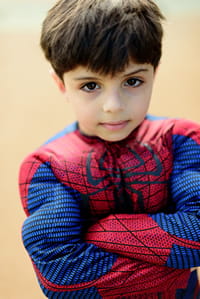
If you’re buying new window blinds or bought new blinds from a UK manufacturer or retailer in the last few years and fitted them according to the manufacturer’s instructions, child safety is almost certainly locked into the deal.
However, if you have window blinds that were purchased prior to early 2014, they might not meet the current child safety standards. This is something that you should check and rectify as soon as possible, if relevant; but the good news is that making even older window blinds safer for children is not difficult, even if DIY is very much Not Your Thing.
If you managed to keep your child alive through the weirdness that was 2020 with its various restrictions, lockdowns, and general difficulties, you’re already totally winning at parenting and probably deserve an award of some sort. That being the case, rest assured that making older window blinds safe for children will be an absolute breeze in comparison.
This blog post will provide direction on how to tell if your older window blinds meet the current British Standard for child safety or not, and provide direction on how to make older blinds child-safe quickly and easily.
Children and window blinds: What’s the risk?
Let’s start with the basics then; we all know that when it comes to finding risk in the most seemingly innocuous of places, children are the world’s finest athletes. But how can window blinds pose a risk to children?
Essentially, it comes down to the potential danger posed by the cords or chains used to open and close some types of blinds, and any loops or potential for entanglement within those cords or chains. To a lesser extent, blinds can pose a risk to children if they were to pull or lean their weight on a cord or chain (or the blind itself) and pull the whole array down, but this latter is only really likely to happen if your blinds were hanging by a thread anyway, and also, your child is The Hulk.
This means that negating the risk of hanging cord or chain loops as part of window blinds is 99.9% of the battle won when it comes to making window blinds safe for kids.
This facet of window blind child safety is covered under the remit of British Standard EN 13120, and this was updated in February 2014 to add a couple of additional caveats; which means that blinds purchased before that date might not meet the current child safety standards.

Why might older window blinds pose a risk to child safety?
Changes to the required British Standard for blinds that were introduced in 2014 mean that blinds bought since then have to have specific child safety devices relating to their chains and cords either supplied along with the blind, or integrated into the design of the blind itself.
However, blinds bought or fitted earlier than 2014 may not have these features in place, and this means that a large number of UK homes could have blinds installed that might pose a risk to child safety.
As we all know, most children are really good at posing a risk to their own safety without needing any help from their environment; so the Wise Parent has a chance to get ahead of the game here, and pre-empt any unnecessary trips to A&E by checking and correcting potential safety failings in older blinds before they become an issue.
How can I tell if my older window blinds are child-safe?
First of all, just because your blinds pre-date 2014 doesn’t mean that they’ve necessarily been lying in wait all this time just hoping to snarl up an unsuspecting child.
New child safety requirements for window blinds passed into the BS regulations in early 2014; but plenty of window blinds sold before that point incorporated such features anyway, and many people will have integrated additional safety features at the time that they fitted their blinds too, even if they don’t specifically remember doing so now.
The things you need to check in terms of older blinds (or if you’re not sure of the age of your blinds) are:
- The distance the cord or chain used to control the blind hangs off the ground, and;
- Depending on the measurement you get, if there’s a cord tidy or breakaway device built into the cord or chain too.
Preventing a child from hanging up or choking due to getting entangled in a blind’s cord or loop means you either need to keep that cord or loop well out of their reach, or shorten it as far as possible and check for/fit a breakaway device; so that if the child did manage to get caught up in it, it would snap before any serious harm was done.
How to make older window blinds safer for children
If your blind’s cord or chain finishes 150cm or more above floor level at the lowest point, it is in compliance with the updated standard’s requirements and deemed appropriately safe.
If your blind’s chain or cord hangs between 150cm and 60cm from the floor, it will still be compliant and so, child safe in this context, if there’s a breakaway device installed on it. Put simply, this serves as the weak link in the chain (or cord) that in this context, could save a life.
A breakaway device is designed to release or snap in the event of a certain level of pressure being applied to it; such as if a child got their head into the loop of the chain or cord and leaned their weight into it. If a device like this is in place, the end of the chain or cord can fall as close as 60cm from the floor at the lowest point.
Newer (February 2014-onwards) blinds come with the relevant safety devices like a p-clip cord tidy or a breakaway fitted or supplied as standard, but you can also buy and retrofit these to your older blinds in just a few minutes.
A blind cord or chain that is 60cm or less from the floor doesn’t meet the current safety standard, even with a breakaway device; so bear this in mind if, say, you have blinds on floor-to-ceiling windows, or patio doors with blinds that have very long cords.
Cleats and ties
Cleats should be fitted to the wall alongside of your blind, to hold the cord safely out of the way at all times when not in use. These should be fitted 150cm or higher than the ground in accordance with the regulations, and when you use them, wind the cord around them in a figure of eight shape to keep them secure.
Finally, don’t forget that keeping your blind’s cords out of your child’s reach from floor level only works if your child remains at floor level; the edge of a bed, toy box, chair, and a whole host of other things can serve as climbing equipment to allow your child to reach your blinds or their cords if you’re not careful.

So if (or rather, when) your child becomes a little more mobile and mischievous or starts showing signs of having been bitten by a radioactive spider, make sure there’s not a convenient item of furniture serving as a stepping stone to give them a leg-up to your blinds either.




